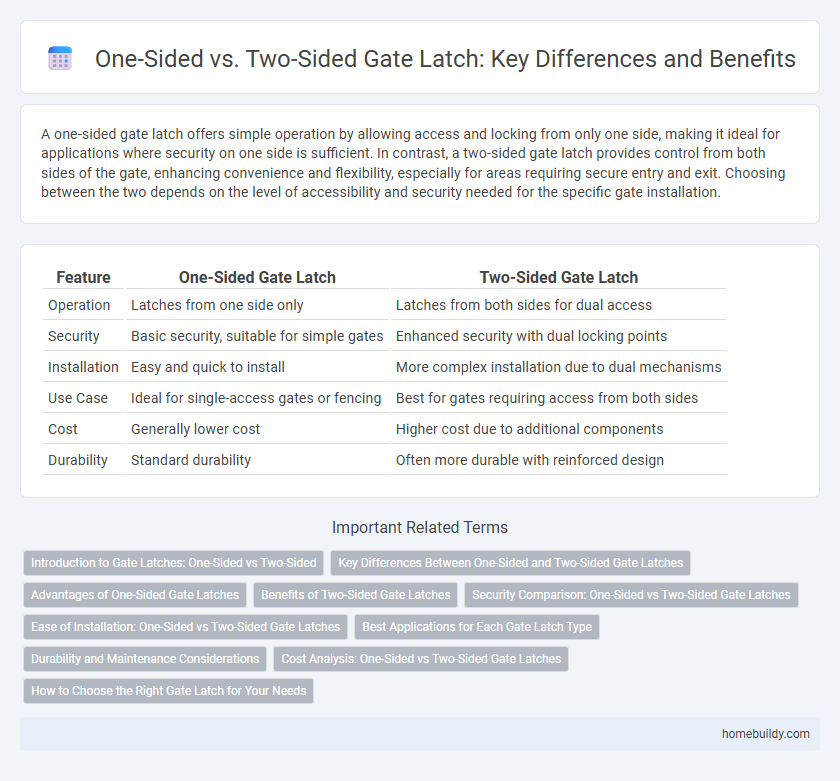A one-sided gate latch offers simple operation by allowing access and locking from only one side, making it ideal for applications where security on one side is sufficient. In contrast, a two-sided gate latch provides control from both sides of the gate, enhancing convenience and flexibility, especially for areas requiring secure entry and exit. Choosing between the two depends on the level of accessibility and security needed for the specific gate installation.
Table of Comparison
| Feature | One-Sided Gate Latch | Two-Sided Gate Latch |
|---|---|---|
| Operation | Latches from one side only | Latches from both sides for dual access |
| Security | Basic security, suitable for simple gates | Enhanced security with dual locking points |
| Installation | Easy and quick to install | More complex installation due to dual mechanisms |
| Use Case | Ideal for single-access gates or fencing | Best for gates requiring access from both sides |
| Cost | Generally lower cost | Higher cost due to additional components |
| Durability | Standard durability | Often more durable with reinforced design |
Introduction to Gate Latches: One-Sided vs Two-Sided
One-sided gate latches feature a latch mechanism accessible from only one side, making them ideal for securing gates where access control is required on a single side. Two-sided gate latches allow operation from both sides of the gate, providing convenience and functionality in areas where gates need to be opened and closed from either side. Choosing between one-sided and two-sided gate latches depends on security needs, user accessibility, and gate usage frequency.
Key Differences Between One-Sided and Two-Sided Gate Latches
One-sided gate latches are designed for single access points, allowing operation from only one side, making them ideal for simple gate security and privacy. Two-sided gate latches provide access control from both sides, enhancing convenience for gates that require entry and exit uses, often featuring a locking mechanism on both sides. The key difference lies in accessibility and security: one-sided latches are simpler and more secure for controlled entry, while two-sided latches offer flexibility and ease of use for frequently accessed gates.
Advantages of One-Sided Gate Latches
One-sided gate latches offer straightforward installation and ease of use, requiring access from only one side of the gate, which enhances convenience in settings with limited entry points. They provide enhanced security by simplifying control over gate access without the need to reach through or around the gate. This design is particularly advantageous for residential and commercial applications where quick, single-sided operation is essential.
Benefits of Two-Sided Gate Latches
Two-sided gate latches offer enhanced security by requiring access from both sides, reducing the risk of unauthorized entry compared to one-sided latches. They provide greater convenience for properties with multiple entry points, allowing users to operate the gate from either side without needing to walk around. This design improves overall gate functionality and durability, making two-sided latches ideal for high-traffic areas and commercial applications.
Security Comparison: One-Sided vs Two-Sided Gate Latches
One-sided gate latches provide basic security by allowing access from only one side, reducing the risk of unauthorized entry but potentially limiting functionality. Two-sided gate latches enhance security by requiring authentication or a key from both sides, offering better control over gate access in high-security areas. Choosing between one-sided and two-sided gate latches depends on the required security level, with two-sided options favored for commercial or vulnerable residential properties.
Ease of Installation: One-Sided vs Two-Sided Gate Latches
One-sided gate latches offer straightforward installation, requiring only access to one side of the gate, making them ideal for fences against walls or where only one side is reachable. Two-sided gate latches necessitate installation on both gate panels, often involving additional alignment and mounting on opposite sides, which can increase installation complexity and time. Selecting between these latches depends on gate design and accessibility, with one-sided options favored for simpler, quicker setups.
Best Applications for Each Gate Latch Type
One-sided gate latches are ideal for residential fences where security and ease of use from one side are priorities, such as garden gates or backyard enclosures. Two-sided gate latches provide enhanced security and functionality for commercial or high-traffic areas, enabling gate operation from both sides, perfect for public parks or shared property access points. Selecting the appropriate gate latch depends on factors like access control needs, gate orientation, and user convenience requirements.
Durability and Maintenance Considerations
A one-sided gate latch typically features simpler construction, resulting in fewer moving parts and lower maintenance requirements, but may experience uneven wear concentrated on the latch side, potentially reducing durability over time. Two-sided gate latches distribute mechanical stress across both sides of the gate, enhancing durability and requiring periodic lubrication of hinges and latch components to maintain smooth operation. Choosing between one-sided and two-sided latches depends on factors such as gate usage frequency, exposure to weather elements, and the desired balance between maintenance effort and long-term reliability.
Cost Analysis: One-Sided vs Two-Sided Gate Latches
One-sided gate latches generally incur lower initial costs due to simpler design and easier installation, making them suitable for budget-conscious projects. Two-sided gate latches, while more expensive upfront, offer enhanced security and durability that can reduce long-term maintenance and replacement expenses. Evaluating total cost of ownership reveals two-sided latches provide better value in high-traffic or high-security applications despite the higher initial investment.
How to Choose the Right Gate Latch for Your Needs
Selecting the right gate latch depends on security requirements and gate design. One-sided gate latches offer easy access from one side, ideal for privacy gates, while two-sided latches provide locking mechanisms operable from both sides, enhancing security for gates with frequent dual access. Evaluate gate usage frequency, desired security level, and convenience to determine the optimal latch type for your property.
one-sided gate latch vs two-sided gate latch Infographic

 homebuildy.com
homebuildy.com